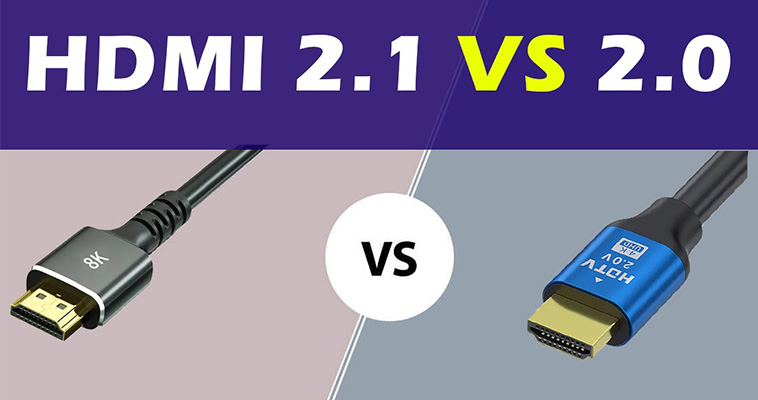HDMI 2.1 vs. 2.0 Introduction
HDMI 2.0 is an important upgrade in the HDMI specification. It provides a maximum bandwidth of 18Gbps and supports 4K resolution (3840×2160)@ 60Hz refresh rate. This version is suitable for most 4K video and audio transmission needs, supports static HDR, improves video quality, suitable for standard display and general enterprise applications.
HDMI 2.1 is currently the most advanced HDMI version with a bandwidth of up to 48Gbps and supports 8K resolution @ 60Hz and 4K @ 120Hz, which is suitable for high -quality video needs. It also supports dynamic HDR and EARC (enhanced audio return channels) and low latency mode, which can significantly improve the video and audio experience. It is an ideal choice for high -end conference rooms, video walls and interactive display.
In today’s digitalization, the importance of high -definition connection technology to enterprises is self -evident. With the launch of HDMI (High Definition Multimedia Interface) 2.1 and HDMI 2.0 technologies, companies are facing the challenge to choose the best HD connection solution. This article will compare HDMI 2.1 and HDMI 2.0 in detail, providing enterprises with the best solution.
HDMI 2.0 technical advantage
HDMI 2.0 technology has the following advantages compared to the early version of HDMI:
- Higher bandwidth: HDMI 2.0 provides 18Gbps bandwidth, which is much higher than the 10.2Gbps of HDMI 1.4, and can support video signal transmission with higher resolution and higher frame rate.
- Support 4K resolution: HDMI 2.0 can transmit 4K video signals, support the maximum resolution of 3840 × 2160 pixels, making viewing 4K video content clearer and realistic.
- Support higher frame rate: HDMI 2.0 supports up to 60Hz frame rate, which can provide smoother pictures for games and dynamic video content.
- Support more extensive color gamut: HDMI 2.0 supports a wider range of color range and can transmit more real colors and details.
- Support HDR: HDMI 2.0 also supports high dynamic range (HDR) technology, which can provide more vivid and realistic picture effects.
In general, HDMI 2.0 technology makes video signal transmission more high -definition, smooth, and authentic, bringing better movie viewing and gaming experience to users.
HDMI 2.1 technical highlight
- High -resolution support: HDMI 2.1 supports 8K resolution and the refresh rate of 60Hz, and also supports 4K resolution and 120Hz refresh rate to provide users with a clearer and smooth movie viewing experience.
- Dynamic HDR: HDMI 2.1 supports dynamic HDR technology, which can adjust the brightness and contrast in real time according to the requirements of the content, showing a more realistic picture effect.
- Automatic low latency mode (ALM): HDMI 2.1 supports ALM technology, which can automatically reduce the input delay in the game mode, allowing players to feel the fast pace and tension atmosphere of the game more smoothly.
- Inverter frequency transmission: HDMI 2.1 supports variable data transmission rates, which can dynamically adjust the bandwidth according to the needs of the content to ensure that the signal transmission is more stable and efficient.
- Quick frame transmission: HDMI 2.1 supports fast -frame transmission technology, which can minimize the input delay, improve the game experience and better support virtual reality and enhanced reality technology.
- EARC technology: HDMI 2.1 also supports enhanced audio return channel (EARC) technology, which can provide higher -quality audio transmission, support high -definition audio formats such as Dolby ATMOS and DTS: X.
In summary, HDMI 2.1 technology has significantly improved in high -definition, dynamic HDR, low latency, frequency conversion transmission, fast frame transmission and high -quality audio, etc., bringing more comprehensive and high -quality viewing and high -quality movie viewing and high -quality viewing. Game experience.
HDMI 2.1 vs. 2.0 Comparison of Parameters
| Spec | HDMI 2.0 | HDMI 2.1 |
| Bandwidth | 18 Gbps | 48 Gbps |
| Resolution and refresh rate | 4K60Hz | 10K120Hz |
| Dynamic HDR and color performance | Support static HDR, color performance is not as good as HDMI 2.1, but it is still applicable to standard enterprise display needs | Support dynamic HDR, ensure that each frame of the image can adjust the brightness and contrast, and provide more accurate color performance |
| Audio and audio and painting synchronization | Only support ARC (audio return channel), the function is relatively basic | Support EARC (enhanced audio return channel), which can transmit non -damaged audio and suitable for high -quality audio needs. |
Enterprise chooses the best connection solution
- Routine display: HDMI 2.0 is enough to meet the demand for 4K content display.
- High -resolution and low latency requirements: such as design workstations, video walls, interactive display and other scenarios, HDMI 2.1 is recommended.
HDMI 2.1 vs. 2.0 Common problem
1、How to upgrade the existing HDMI device?
You can upgrade the existing HDMI device by purchasing a newer version of the device or by using an HDMI adapter or converter to add new features or capabilities.
2、Is the cost of HDMI 2.1 worth it?
It depends on your specific needs and budget. If you have a device that supports HDMI 2.1 and you want the enhanced features and capabilities it offers, then the cost may be worth it for you. However, if you don’t have a need for those features or if the cost is prohibitive for your budget, then it may not be worth it.







